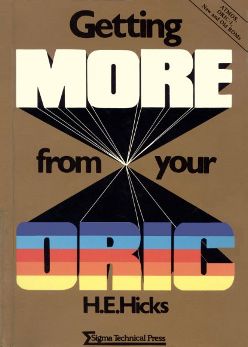BOOK REVIEW #4
![]()
Getting More From Your Oric
by H.E.Hicks
 |
INTRO. Sometimes you come across
something like this and wish you'd seen it years ago.
This is just the sort of book I yearned for in the
eighties. If I'd found it then, I might have been
programming in machine code by now. THE BOOK.
The back of this book declares, "The Ultimate 'How-To'
Book for the ORIC-1 and Atmos Computers". A bold
claim indeed! Some may say the Advanced User Guide is the
best of the more advanced books. So is this any good ?
You bet your bottom it is ! |
| WHAT'S IN IT ? 200 pages are
enough to cover many subjects. There are eight chapters
with seven appendices. The first chapter starts at the
beginning with useful things, such as, how to switch on !
Then we are introduced to Oric's BASIC. Perhaps this
chapter could be a little bigger, but it gives a straight
forward explanation with examples. Chapter three starts
to delve deeper inside and gives descriptions of the main
chips and shows how memory is mapped. The following chapters start to deal with how computers count, and that's a sure sign we are into machine code land. BASIC isn't forgotten though and we are shown how BASIC works and how the computer deals with BASIC code. Ever more complicated subjects are dealt with in an easy to understand manner, and you are led deeper and deeper into the complexity of machine code. The final chapter list and explains some example programs. These vary from sideways scrolling to getting the Oric to play music. Following this the appendices list the usual useful codes and op-codes and also gives some assembly language programs including a cassette loader program ! SUMMARY.
The Advanced User Guide is a wonderful book. So is
this one. This book cannot take the place of the AUG as
it has no ROM disassembly. The AUG does not cover all the
aspects in this book and does not explain things so well,
or in such an easy to understand manner. The ideal is
then to have both books. One compliments the other so
well. I think every home should have one, and I rate the book 9 out of ten. |
|
© Copyright 2000 by S.D.Marshall email me